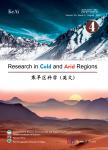Spatio-temporal variation of soil CO_(2) concentration in Loess Area of northwestern Shanxi Province,China
Spatio-temporal variation of soil CO2 concentration in Loess Area of northwestern Shanxi Province, China作者机构:College of Geography Science and TourismShaanxi Normal UniversityXi'anShaanxi 710062China Institute of Karst GeologyChinese Academy of Geological SciencesGuilinGuangxi 541000China Research Center for Scientific Development in Fenhe River BasinTaiyuan Normal UniversityTaiyuanShanxi 030001China SNNU-JSU Joint Research Center for Nano-environment Science and HealthShaanxi Normal UniversityXi'anShaanxi 710062China
出 版 物:《Research in Cold and Arid Regions》 (寒旱区科学(英文版))
年 卷 期:2022年第14卷第3期
页 面:196-211页
核心收录:
基 金:supported by the National Natural Science Foundation, Grant No. 41671213 the Fundamental Research Funds for the Central Universities, No. GK201803055 Shaanxi prov‐ince Postdoctoral Science Foundation No. 2016 BSHEDZZ27
主 题:soil CO_(2)concentration China Loess Plateau carbon sink function release potential
摘 要:CO_(2) released by soil serves as an important link between terrestrial ecosystems and atmospheric CO_(2), whose small chang‐es may significantly affect the global carbon cycle. In order to reveal the spatio-temporal variations of CO_(2) concentrations in deep loess, this paper takes Qingliangsi Gully watershed in northwestern Shanxi Province, China as an example to sys‐tematically study soil CO_(2)concentration and its spatio-temporal variations and carbon sink significance under different watershed locations and different land use types. Results show that: (1) The release potential of the loess soil is larger in the depth range of 2 m, which is much more likely to be the CO_(2) release area. (2) Grassland and forest are more advanta‐geous in terms of soil microbial activity and soil carbon reserve compared with farmland. In addition, the change of land use type from farmland to grassland can increase soil organic carbon reserve, which is of far-reaching significance to the global carbon cycle. This is especially true in an area like the Loess Plateau with densely covered hills, gullies, and serious soil erosion in an area of 64×104 km2. (3) In the study area, the diurnal concentration of soil CO_(2) at different depths shows a weak high-low-high-low trend from 08:00 to 07:00 next day;and in deep soil it has a lag time compared with the daily change of temperature, generally about 4−12 h, which may be caused largely by the more compact loess structure. It is worth pointing out that the Loess Plateau in China, with a thickness of the loess of tens to hundreds of meters, has the most abundant soil resources in the world, and also stores a large amount of terrestrial soil carbon, which carries the hope of promoting the research of global carbon cycle.



